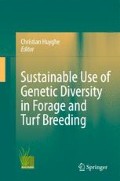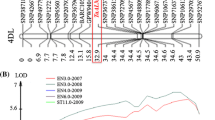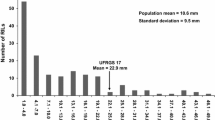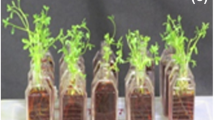Abstract
Aluminum (Al) toxicity in acid soils is one of the factors limiting crop production. Alfalfa (Medicago sativa L.) is one of the most important forage legumes worldwide and is susceptible to Al toxicity. Al tolerance in alfalfa was identified in a diploid Medicago sativa subs. caerulea accession (Sledge et al., 2002) and has been successfully integrated at the tetraploid level in the Al-tolerant genotype Altet-4. The goals of this study are to identify and confirm quantitative trait loci (QTL) for Al-tolerance in tetraploid alfalfa. Two populations of at least 190 individuals each were developed from crosses between Altet-4 (Al-tolerant) and the Al-susceptible genotypes 95-608 derived from CUF-101, and NECS141, a semi-dormant breeding line developed in Iowa. The parental lines and the progeny from the mapping populations were screened using a callus bioassay and a whole plant assay. Genetic linkage maps constructed using EST-SSR markers (Sledge et al., 2005) were developed and used to identify QTL associated with Al tolerance. Comparison of QTL identified using different screening methods will be discussed. The long-term goal of this research is to use molecular markers associated with the Al-tolerance trait to accelerate the development of alfalfa cultivars with improved productivity in acidic and Al-toxic soils.
Similar content being viewed by others
Keywords
Introduction
Aluminum (Al) is an important factor limiting crop productivity in acid soils. At low pH, Al is soluble in the soil and is accessible to the plant which leads to inhibition of root growth and plant productivity (Kochian, 1995; Rechcigl et al., 1988). Surface lime application is commonly used to prevent growth losses associated with Al toxicity, but these amendments are often not economical or practical due to high energy inputs and the increase in establishment costs (Haby et al., 2002; McLay et al., 1994; Summers, 1998). Therefore, a viable alternative to lime application is the development of Al tolerant crops (Foy, 1988). Alfalfa is one of the most important forage legume species in agricultural production systems. Alfalfa requires little or no nitrogen fertilizer because of its ability to carry out symbiotic nitrogen fixation. Its biomass can be harvested multiple times during the growing season (Barnes, 1993). Due to the production of more protein per hectare than grain or oilseed crops, alfalfa is highly desirable for hay production and pasture for livestock. Alfalfa is set to become an integral component of a sustainable bio-fuel industry (Lamb et al., 2007), especially if factors limiting its productivity are overcome. Alfalfa is very sensitive to soil acidity and Al toxicity; therefore, its biomass yields and ability to persist are compromised due to inhibited root growth in soils with low pH. Limited variation for Al tolerance exists within tetraploid Medicago sativa germplasm (Bouton, 1996; Bouton and Sumner, 1983; Dall’Agnol et al., 1996; Hartel and Bouton, 1989), and no commercially available Al-tolerant alfalfa cultivar has been developed. A single Al-tolerant clone, Al-4, was identified in the diploid M. sativa subsp. caerulea (PI464724-25) germplasm and used to develop a diploid F2 mapping population (Bouton, 1996; Sledge et al., 2002). Efforts to introgress Al tolerance from the diploid PI464724-25 at the tetraploid level in alfalfa produced the Al-tolerant tetraploid alfalfa Altet-4, which was obtained from 2X × 4X crosses between Al-4 and CUF101-derived clones. Here we utilize three laboratory and greenhouse screening protocols to assess Al-tolerance in two tetraploid alfalfa mapping populations segregating for Al-tolerance and to identify quantitative trait loci (QTL) for acid and Al tolerance. We also developed a molecular linkage map of tetraploid alfalfa using simple sequence repeat (SSR) markers and candidate gene-based markers.
Materials and Methods
Plant Materials
The diploid Al-tolerant alfalfa Al-4 (Narasimhamoorthy et al., 2007) was crossed with a single genotype from tetraploid alfalfa CUF 101 (Lehman et al., 1983). The resulting progeny (Altet-1 through Altet-4) and the CUF101-derived genotypes 95-608 and 95-653, were tested for Al-tolerance using a callus growth bioassay in Blaydes media as previously described (Parrott and Bouton, 1990). The Al-tolerant genotype Altet-4 was crossed with 95-608 and the NECS-141 breeding line. At least 190 individuals from each cross were randomly selected and each group of individuals was designated as population 608Altet4 and NECS141Altet4.
Al-tolerance Evaluations
Individual seeds from the 608Altet4 F1 mapping population were aseptically germinated by soaking in 70% EtOH for 5 min and rinsed 3X with double distilled sterile water for 5 min. All genotypes were clonally propagated using axillary meristem and terminal meristem subcultured in MS media (Murashige and Skoog, 1962) containing 2 mg/l of Indole-3-butyric acid (IBA) to induce root formation (Ligaba et al., 2006). The three evaluation methods include: (1) callus growth bioassay described by Parrot and Bouton (1990), (2) whole plant assay using a CaCl2 culture media adapted from Ma et al. (1997) containing 1% Gelrite and 0 or 50 μM AlCl3 at a pH of 4.0, and (3) whole plant soil-based assays (Bouton, 1996). For the callus bioassay, leaves and petioles were used to induce callus formation in Blaydes callus induction media and then transferred to either Al- or Al+ Blaydes media (400 μM of AlCl3, pH = 4) (Parrot and Bouton, 1990). The experimental design for the phenotypic evaluations in culture media was a randomized complete block design with three replications.
Molecular Markers, Linkage Map and QTL Mapping
Genomic DNA from two mapping populations was extracted using DNeasy Plant Mini Kit (Qiagen, Valencia, USA). A total of 1024 EST-SSR primer pairs distributed throughout the alfalfa linkage groups (Sledge et al., 2005) were used to evaluate polymorphism between Altet-4, 95-608, and NECS-141 using PCR reactions as previously described (Narasimhamoorthy et al., 2007). Primer pairs that amplified polymorphic fragments were visualized and scored using GeneMapper software. Polymorphic markers were scored based on segregation in the population to achieve maximum resolution on the parental linkage map as described by Hackett et al. (2001). Development of the parental linkage maps and QTL interval mapping were performed using TetraploidMap software (Hackett and Luo, 2003).
Results and Discussion
The relative growth rate of Altet-4 using the callus bio-assay was consistently higher than any other genotype evaluated, including the other Altet genotypes (Fig. 64.1). The CUF101-derived genotype 95-608 had the lowest relative growth rate among the genotypes tested and was consistently the most Al-susceptible germplasm evaluated. Therefore, Altet-4 was used as the Al-tolerant common parent to develop the populations 608Altet4 (non-dormant background) and NECS141Altet4 (semi-dormant background). The phenotypic evaluations for Al tolerance in the 608Altet4 population exhibited a continuous and normal distribution consistent with polygenic inheritance (Fig. 64.2). The relative growth rate values (+Al/–Al) were 0.7 and 1.2 for the 95-608 and Altet-4 parents, respectively. The relative growth rates of the progeny indicate transgressive segregation for Al tolerance in this population and confirm the ability of the assay to detect quantitative differences in Al tolerance. Intriguingly, these findings suggest that both parents may be contributing positive alleles for Al tolerance.
Phenotypic evaluations using the whole plant assay and soil-based assays for the two mapping population will be forthcoming. We will compare the correspondence between and reliability of the three phenotypic evaluation methods to screen for Al-tolerance and help determine which methods are best suited for high throughput screening of large numbers of individuals in populations with relevance to soil. A complete SSR map and identification of QTL associated with Al tolerance will also be updated. These molecular breeding tools will be used to efficiently integrate sources of Al tolerance in alfalfa cultivars.
References
Barnes, D.K. 1993. Alfalfa, Traditional Crop Breeding Practices: An Historical Review to Serve as a Baseline for Assessing the Role of Modern Biotechnology (pp. 135–146). OECD, Paris.
Bouton, J.H. 1996. Screening the alfalfa core collection for acid soil tolerance. Crop Sci. 36:198–200.
Bouton, J.H., Sumner, M.E. 1983. Alfalfa, Medicago sativa L., in highly weathered, acid soils. V. Field performance of alfalfa selected for acid tolerance. Plant Soil 74:431–436.
Dall’Agnol, M., Bouton, J.H., Parrott, W.A. 1996. Screening methods to develop alfalfa germplasms tolerant of acid, aluminum toxic soils. Crop Sci. 36:64–70.
Foy, C. 1988. Plant adaptation to acid, aluminum toxic soils. Comm. Soil Sci. Plant Anal. 19:958–987.
Haby, V.A., Rouquette, F.M., Leonard, A.T. 2002. Requirements for successful alfalfa establishment on acid soils. Res. Center Tech. Rep. 2002:31–32.
Hackett, C.A., Luo, Z.W.. 2003. TetraploidMap: construction of linkage map in autotetraploid species. J. Heredity 94:358–359.
Hackett, C.A., Bradshow, J.E., McNichol, J.W. 2001. Interval mapping of quantitative trait loci in autotetraploid species. Genetics 159:1819–1832.
Hartel, P.G., Bouton, J.H. 1989. Rhizobium-meliloti inoculation of alfalfa selected for tolerance to acid aluminum-rich soils. Plant and Soil 116:283–285.
Kochian, L.V. 1995. Cellular mechanisms of aluminum toxicity and resistance in plants. Annu. Rev. Plant Physiol. Plant Mol. Biol. 46:237–260.
Lamb, J.F.S., Jung, H.-J.G., Sheaffer, C.C., Samac, D.A. 2007. Alfalfa leaf protein and stem cell wall polysaccharide yields under Hay and Biomass management systems. Crop Sci. 47:1407–1415.
Lehman, W.F., Nielson, M.W., Marble, V.L., Stanford, E.H. 1983. Registration of CUF 101 alfalfa. Crop Sci. 23:398.
Ligaba, A., Katsuhara, M., Ryan, P.R., Shibasake, M., Matsumoto, H. 2006. The BnALMT1 and BnALMT2 genes from rape encode aluminum-activated malate transporters that enhance the aluminum resistance of plant cells. Plant Physiol. 142:1294–1303.
Ma, J.F., Zheng, S.J., Li, X.F., Takeda, K., Matsumoto, H. 1997. A rapid hydroponic screening for aluminum tolerance in barley. Plant and Soil 191:133–137.
McLay, C.D.A., Ritchie, G.S.P., Porter, W.M., Cruse, A. 1994. Amelioration of subsurface acidity in sandy soils in low rainfall regions 2. Changes to soil solution composition following the surface application of gypsum and lime. Aust. J. Soil Res. 32:847–865.
Murashige, T., Skoog, F. 1962. A revised medium for rapid growth and bioassays with tobacco tissue cultures. Physiol. Plant 15:473–497.
Narasimhamoorthy, B., Bouton, J.H., Olsen, K.M., Sledge, M.K. 2007. Quantitative trait loci and candidate gene mapping of aluminum tolerance in diploid alfalfa. Theor. Appl. Genet. 114:901–913.
Parrott, W.A., Bouton, J.H. 1990. Aluminum tolerance in alfalfa as expressed in tissue culture. Crop Sci. 30:387–389.
Rechcigl, J.E., Reneau, J.R.B., Zelazny, L.W. 1988. Soil solution Al as a measure of Al toxicity to alfalfa in acid soils. Comm. Soil Sci. Plant Anal. 9:989–1001.
Sledge, M., Ray, I., Jiang, G. 2005. An expressed sequence tag SSR map of tetraploid alfalfa (Medicago sativa L.). Theor. Appl. Genet. 111:980–992.
Sledge, M.K., Bouton, J.H., Dall’Agnoll, M., Parrott, W.A., Kochert, G. 2002. Identification and confirmation of aluminum tolerance QTL in diploid Medicago sativa subsp. coerulea. Crop Sci. 42:1121–1128.
Summers, C.G. 1998. Integrated pest management in forage alfalfa. Integrated Pest Manag. Rev. 3:127–154.
Acknowledgements
This research has been funded by The Samuel Roberts Noble Foundation, Inc.
Author information
Authors and Affiliations
Corresponding author
Editor information
Editors and Affiliations
Rights and permissions
Copyright information
© 2010 Springer Science+Business Media B.V.
About this paper
Cite this paper
Khu, DM., Reyno, R., Brummer, E.C., Bouton, J.H., Han, Y., Monteros, M.J. (2010). QTL Mapping of Aluminum Tolerance in Tetraploid Alfalfa. In: Huyghe, C. (eds) Sustainable use of Genetic Diversity in Forage and Turf Breeding. Springer, Dordrecht. https://doi.org/10.1007/978-90-481-8706-5_64
Download citation
DOI: https://doi.org/10.1007/978-90-481-8706-5_64
Published:
Publisher Name: Springer, Dordrecht
Print ISBN: 978-90-481-8705-8
Online ISBN: 978-90-481-8706-5
eBook Packages: Biomedical and Life SciencesBiomedical and Life Sciences (R0)






